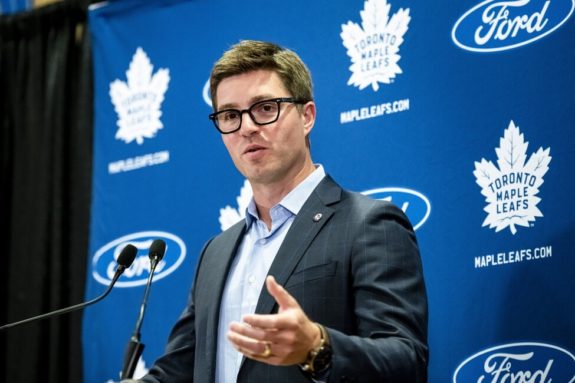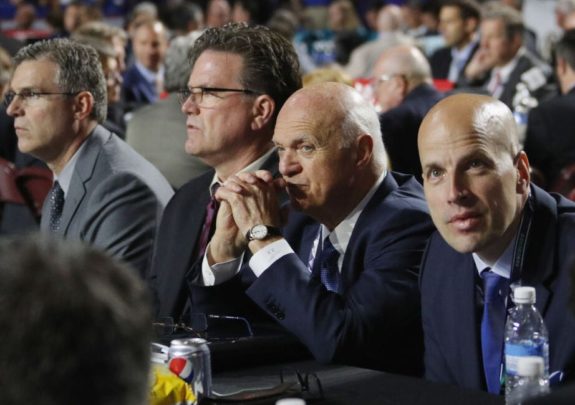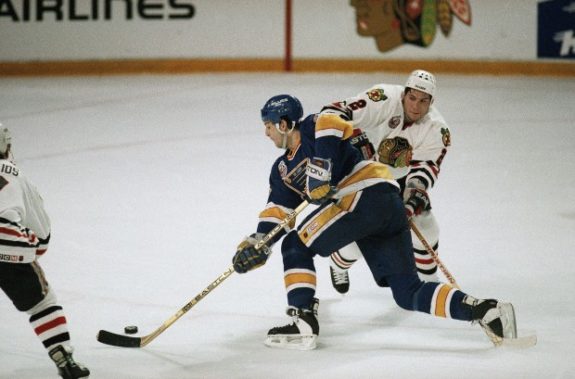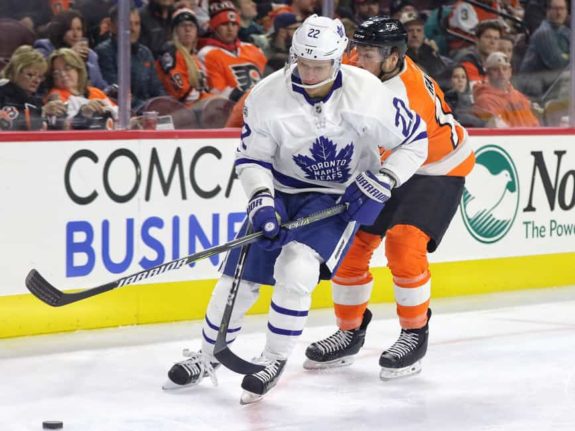*Originally published after the 2019-20 season
With the Toronto Maple Leafs now removed from postseason play – yet again – it’s the work of analysts to review the season with and for fans. One way to address fans’ concerns is by inviting them to respond – or to vent – about the events of the 2019-20 season. I read these “mailbag” articles with interest.
Related: Maple Leafs News & Rumors: Analyzing Gudas & Larsson as Trade Targets
There’s a group of Maple Leafs fans who really dislike the path that president Brendan Shanahan, former general manager Kyle Dubas, and head coach Sheldon Keefe took the team. These fans are critical of management’s philosophy for building a team for Canada’s largest city and one of the country’s great hockey markets. I don’t know how big that group is, but I do know they are vocal (from Mailbag: Fire Shanahan? Fire Dubas? Trade Nylander? Readers have all the answers on how to fix the Maple Leafs, Toronto Star, 21/08/20).

One redundant critique is that the team’s management is second-rate compared to former general manager Lou Lamoriello. In this post, I’ll consider Lamoriello’s career with the team to see whether they are correct.
Two things: First, I didn’t follow Lamoriello’s tenure with the team very closely, certainly not as close as I follow the Maple Leafs now that I write about them almost every day. Second, I am a fan of Dubas and like the philosophy by which the team is being built. I find it exciting hockey, and, logically, it makes sense to me.
With those caveats, I’ll review the history of the iconic general manager of the New Jersey Devils, the Maple Leafs, and now the New York Islanders. He’s an old guy, about my age – which I like – and he’s been around hockey a long time.
Lamoriello’s Time with the New Jersey Devils
Lamoriello became the general manager of the Devils in 1987 and stayed in that role until 2015. It was the third-longest period of time a general manager had been with one team: only Conn Smythe (who was general manager of the Maple Leafs for 30 seasons) and Art Ross (who was general manager of the Boston Bruins for 30 seasons) had longer tenures
When Lamoriello took over the Devils, the team had never been competitive. Before moving to New Jersey in 1982-83, they were the Colorado Rockies and before that the Kansas City Scouts. Over time, Lamoriello turned the Devils into one of the most successful teams in the NHL.

From 1988, the Devils regularly made the Stanley Cup Playoffs. In fact, they made the postseason in all but three seasons between 1988 and 2012. They played in the Stanley Cup Final in 1995, 2000, 2001, 2003, and 2012. And, during those five Finals, they won the Stanley Cup in 1995, 2000, and 2003. In 2015, Lamoriello left the Devils (after he handed Ray Shero the general manager duties but remained as team president) to become the 16th general manager of the Maple Leafs.
Related: Roger Neilson: Coaching Genius & Innovator
During his time in New Jersey, Lamoriello had a reputation for recognizing talent, for keeping his team financially sound, and for encouraging player loyalty. He found Hall of Fame goalie Martin Brodeur with the 20th overall pick in the 1990 NHL Entry Draft and picked Patrik Elias 51st overall in the 1994 NHL Entry Draft.
Both Brodeur (except for seven games with the St. Louis Blues in 2014-15) and Elias stayed with the Devils their entire careers. We know Brodeur’s career path, and he regularly signed below-market contracts to stay with the Devils. Elias played 20 NHL seasons with the Devils and is the franchise’s leader in points, goals, assists, most points during a single season (96), and game-winning goals (79). After the great Jaromir Jagr, he’s the second-ranked Czech player in career NHL points.
Lamoriello’s Time with the Maple Leafs
In 2014, Hockey Hall of Famer Shanahan was appointed to the position of president and alternate governor of the Maple Leafs. He and Lamoriello had a history; Lamoriello drafted Shanahan 2nd overall in the 1987 NHL Draft. Shanahan played four seasons with the Devils before signing a four-year deal with the Blues as a restricted free agent in 1991. (The Devils were awarded defenseman Scott Stevens as compensation for losing Shanahan.)

Obviously, Shanahan remembered Lamoriello well enough that, when the long-time general manager of the Devils was “down-sized” in New Jersey, he asked him to be part of the team in Toronto. In 2015, a year after Shanahan began his time with the Maple Leafs, Lamoriello joined him as the general manager. That job lasted until the Maple Leafs were defeated by the Boston Bruins in April during the 2018 postseason.
Related: 10 Reasons Hockey Is the Greatest Sport on Earth
At the time, Shanahan announced that Lamoriello would not be back as general manager but would stay with the team in the role of a senior adviser and that when Lamoriello was hired in 2015, the plan was for him to be the general manager for three years before transitioning to senior adviser for four more years. Shanahan decided to stick with that plan.
In his time with the Maple Leafs, Lamoriello helped Shanahan rebuild a team that had only made the playoffs once in ten years. During his last two seasons as general manager, they made the postseason both times. Hiring and then removing Lamoriello suggests that Shanahan might be as tough-minded as Lamoriello. It was the only position Lamoriello held during his career as an NHL executive that he didn’t have the final say in hockey operations.
You may also like:
- Maple Leafs Should Keep Murray as Third Goaltender
- Flames & Maple Leafs Trade History Revisited
- 3 Players the Maple Leafs Could Target on a PTO
- NHL Rumors: Oilers, Maple Leafs, Capitals, Kuznetsov News
- Maple Leafs Should Target Evgeny Kuznetsov as Reclamation Project
By the end of May 2018, the New York Islanders hired him to be their president of hockey operations. By June, he had fired previous general manager Garth Snow and then head coach Doug Weight. He named himself general manager and hired Barry Trotz, who had just won the Stanley Cup as head coach of the Washington Capitals.
The rest is history. The Maple Leafs lost in the Qualifying Round of this year’s playoffs and the Islanders remain alive. There’s no doubt the Islanders’ on-ice product has improved since Lamoriello became their general manager.
What’s the Verdict on Lamoriello’s Time with the Maple Leafs?
You either love Lamoriello or you don’t. His time with the Maple Leafs was checkered. Known for his hard-nosed salary negotiations in New Jersey, he signed Nikita Zaitsev to a huge long-term $4.5 million contract that lasts through the 2023-24 season. The Maple Leafs traded that contract to the Ottawa Senators and had to take Cody Ceci’s similar $4.5 million contract, which is now up. That trade also cost the team Connor Brown, who did well with the Senators.

Lamoriello also signed Patrick Marleau at $6.25 million. In June 2019, Dubas dumped that contract on the Carolina Hurricanes and lost a first-round draft pick as a result.
Many also believe that he could have negotiated with Mitch Marner, Auston Matthews, and William Nylander at a time when their contracts could have been lower. He also gave Matthews bonuses that he refused to give Marner. I wonder if Marner’s intransigence to sign for anything less than Matthews was a result of such differential treatment. One can never know these things, but logic supports the thought.
Related: What Happens if the Maple Leafs’ Nick Robertson Is Really Good?
Finally, Lamoriello signed depth winger Matt Martin for four seasons at $2.5 million per season, and Martin never had a 20-point season in his career. He was a great player but was he worth his contract? He didn’t stay long with the team.
In fact, many of the salary-cap issues the Maple Leafs now face were generated as a result of contracts signed by Lamoriello. You can make a case that he has been a great general manager during his long career, but it’s a more difficult case to argue that he was great in Toronto.
The verdict? Lamoriello turned the Maple Leafs franchise around. However, some of the issues the team now faces are a result of his poor decisions. In that, he’s probably like many other NHL general managers.
